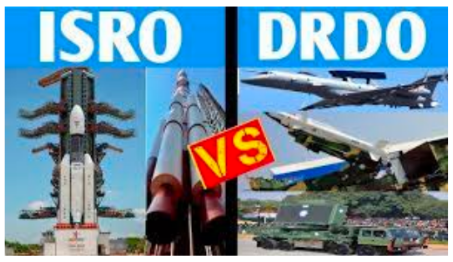Answer:
Approach:
- Introduction: Briefly introduce ISRO and DRDO as India’s premier institutions for space and defense research.
- Body:
- Discuss the factors of ISRO’s Success.
- Start with a case study of Chandrayaan-3 to exemplify the collaborative and multidisciplinary nature of ISRO.
- Shift focus to DRDO’s specific defense mandate and how it differentiates from ISRO.
- Dive into the broader repercussions of their work.
- Conclusion: Conclude, emphasizing the importance of their advancements for India’s global standing.
|
Introduction:
ISRO (Indian Space Research Organisation) and DRDO (Defence Research and Development Organisation) are two of India’s leading research institutions, contributing to space research and defense technology respectively. While both have achieved notable success, there is variance in their outcomes and success rates.
Body:
This difference can be attributed to various factors.
ISRO’s Factors of Success:
- Collaborative Effort:
- All-inclusive Approach: Chandrayaan-3, a landmark mission, showcases the true spirit of collaboration with multiple ISRO centers and external partners contributing.
- Centers Involved: From the U R Rao Satellite Centre in Bengaluru to the Space Physics Laboratory, multiple centres played specific roles in the mission’s success.
- Integrated Technological Development:
- Multi-disciplinary Expertise: Space missions require expertise in diverse domains. Chandrayaan-3 saw contributions from thermal engineering experts, power system engineers, communication engineers, and more.
- Comprehensive Testing: From the hot test with propulsion at SDSC-SHAR to integrated sensors and navigation testing, thorough checks ensured the mission’s readiness.
- External Collaboration:
- Partnerships with the Indian Air Force and National Remote Sensing Centre, among others, bolstered the mission’s capabilities.

DRDO’s Factors of Success and Challenges:
- Focused Defense Mandate:
- Unlike ISRO’s broader objective of space exploration and technology, DRDO is sharply focused on India’s defense readiness, requiring constant innovation and upgrading.
- National Security Priorities:
- The evolving geopolitical environment dictates DRDO’s projects, requiring them to be agile and responsive.
- Bureaucratic Hurdles:
- Given the defense focus, certain projects may encounter bureaucratic and budgetary challenges.
- Collaboration with Armed Forces:
- DRDO’s success lies in its collaboration with India’s armed forces, ensuring that technology meets tactical needs.
Implications for India:
- Technological Advancements:
- Successes of both organizations propel India to the forefront of technological innovation, especially in space research and defense technology.
- National Security:
- While ISRO enhances India’s capabilities in satellite technology, aiding defense indirectly, DRDO directly impacts national security through advanced weapons systems.
- Diplomacy and Geopolitics:
- Success in these sectors provides India with diplomatic leverage, reinforcing its position as a regional and global power.
Conclusion:
ISRO and DRDO, both critical pillars of India’s technological landscape, have experienced varying success rates due to their different mandates, collaborations, and challenges. Their continued advancements not only underscore India’s scientific prowess but also fortify its standing on the global stage. Embracing collaboration, multidisciplinary expertise, and evolving with time will ensure their sustained success in the future.
To get PDF version, Please click on "Print PDF" button.


Latest Comments